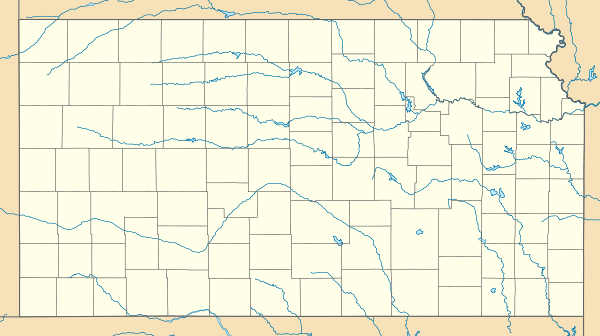Marais des Cygnes Massacre Site
The Marais des Cygnes Massacre Site, also known as Marais des Cygnes Massacre Memorial Park, is a state historic site near Trading Post, Kansas, not far from the Missouri border. It is the site of the 1858 Marais des Cygnes massacre, one of the last major acts of violence in Bleeding Kansas before the American Civil War.[3] The site, now managed by the Kansas Historical Society, is a National Historic Landmark.
Marais des Cygnes Massacre Site | |
 1973 National Park Service photo of the site | |
  | |
| Nearest city | Trading Post, Kansas |
|---|---|
| Coordinates | 38°16′52″N 94°37′12″W |
| Area | 43 acres (17 ha) |
| Built | 1858 |
| NRHP reference No. | 71000317 |
| Significant dates | |
| Added to NRHP | June 21, 1971[1] |
| Designated NHL | May 30, 1974[2] |
Description and history
The Marais des Cygnes Massacre Site is located in a rural setting of eastern Linn County, Kansas, about five miles (8.0 km) northeast of Trading Post. The park covers about 43 acres (17 ha), including the ravine in which the Marais des Cygnes massacre took place on May 19, 1858. The ravine is accessed by a short walk from the site's visitors center, and is marked by interpretive signage. The visitors center is located in a stone house, built in the 1870s by Charles Hadsall.[3]
Bleeding Kansas is the name given to the struggle between pro- and anti-slavery factions for control over the Kansas Territory following passage of the Kansas-Nebraska Act in 1854. The act specified that slavery in that territory would be determined by a popular vote of the territory's inhabitants. This inaugurated a scramble among proponents and opponents of slavery to settle the territory, leading to clashes over land and politics. Significant incidents of violence were minimal after 1856, but the Marais des Cygnes massacre was particularly noteworthy, for the execution-style slaying of five anti-slavery settlers, and the impersonal means by which the victims were chosen. The incident was immortalized by the abolitionist poet John Greenleaf Whittier.[3]
After the massacre, abolitionist firebrand John Brown built a log fort about 220 yards (200 m) south of the ravine; this structure no longer exists. The Hadsall house was built next to it in the 1870s. It was given to the state of Kansas in 1941, which turned it over to the Kansas Historical Society to operate in 1961.[4]
See also
- List of National Historic Landmarks in Kansas
- National Register of Historic Places in Linn County, Kansas
References
- "National Register Information System". National Register of Historic Places. National Park Service. March 13, 2009.
- "Marais des Cygnes Massacre Site". National Historic Landmark summary listing. National Park Service. Archived from the original on 2012-10-11. Retrieved 2011-01-21.
- Richard D. Pankratz (August 22, 1970). "National Register of Historic Places Inventory/Nomination: Marais des Cygnes Massacre Site / Marais des Cygnes Massacre Memorial Park". National Park Service. and Accompanying three photos, from 1965 and 1973
- "Marais Massacre". Kansas State Historical Society's "Kansapedia".